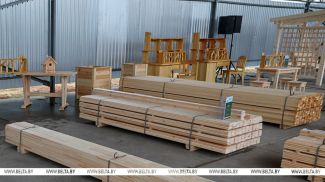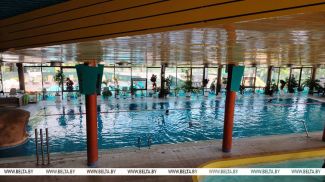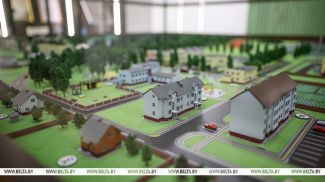
In August 2014 Belarusian President Aleksandr Lukashenko took part in the harvesting of melons on the premises of his official residence Drozdy. That day, watermelons were harvested for the first time on the president's land plot. In a new episode of BelTA’s YouTube project "After the Fact: Lukashenko’s Decisions", we will tell you why Lukashenko grows watermelons, what technologies are used to grow these striped berries, what varieties of watermelons have the highest yield.
How did Belarus start to grow watermelons?
Watermelons were grown in Belarus even before the October Revolution. In 1950 the BSSR decided to resume growing melons. In particular, watermelons. Shestopalov, director of an experimental station in Loshitsa, was engaged in this for ten years. He worked, as they say, on ‘warm soil’. There was no film then.
“They added manure, mixed it with soil, planted crops between the coulisses. Back then, there were no hybrids, no film shelters, no mineral fertilizers. And after 1960, this crop was phased out in Belarus. It started to be imported from Bulgaria, Astrakhan,” Mechislav Stepuro, head of the technological research laboratory at the Scientific and Production Center for Potato, Fruit and Vegetable Growing of the National Academy of Sciences of Belarus, said.

The idea to resume the production of this crop was raised in 2005. The necessary agricultural technologies and procedures were developed upon the instruction of the president. Yet, there was no 100% guarantee that the ‘watermelon business’ would succeed.
“When I met with the president in 2014, he said that skeptics did not believe that watermelons would grow here. But, thank god, skeptics were proved wrong. We harvested about 25-30 tonnes per hectare. It was thanks to our Aleksandr Grigorievich. He had a kind of gut feeling that watermelons would grow well on this piece of land. We checked soil acidity on this plot, it was around 5.7. On other plots it was 4.4, 4.2. Watermelons will not grow there, because they need alkaline soil,” Mechislav Stepuro said.
Thirty tonnes of watermelons were harvested from each hectare. Since then, the yield has increased. Now about 50 tonnes of watermelons are collected per hectare in the presidential land plot.
Where do watermelons from the presidential field go?
In line with an established tradition, watermelons grown on the presidential land plot are shared with nursing homes and boarding schools. For example, in 2017, about six tonnes of watermelons from the presidential field were brought by students of the Ostroshitsky-Gorodok school to a boarding house for pensioners and disabled people. The berries were brought by Nikolai Lukashenko and his classmates as well as upper-form students from this school.

“Do you grow it on your own? Specifically you, do you take an active part in it?” one of the residents of the boarding house asked Nikolai Lukashenko.
“Yes, we do. We take care of them. This year’s largest watermelon weighed 7.5 kg,” Nikolai Lukashenko told the residents of the boarding house.
How has climate change affected watermelon cultivation in our country?
We can say that watermelons are gradually taking root in Belarus. Of course, the striped berry is still far from being as popular as potatoes. But Belarusian watermelons are already served to foreign dignitaries. Steven Seagal came to Belarus in 2016. The movie star liked cold soup, potatoes and, of course, Belarusian lard. He tried carrots from Lukashenko's farmstead, as well as a watermelon.
“We do not have the necessary natural conditions to grow them. But we gave it a try. And the climate has changed a lot,” the head of state told Steven Seagal treating him to a watermelon in August 2016.

The climate has indeed changed. It is a scientific fact. It has become warmer. The boundaries of climatic zones have shifted almost 150-200 km to the south. It has become possible to cultivate heat-loving crops more widely. Yet, local agricultural workers still need to adapt their farming operations to the Belarusian ‘weather swings’.
“Watermelons are a heat-loving crop. Therefore, at all stages of production, including sowing seeds, growing seedlings, and then throughout the growing season, the temperature should be fairly stable, above 0°C and not less than 15°C. During the harvesting period the temperature should not drop below 26°C. Temperature fluctuations negatively affect the cultivation of watermelons,” Tatiana Karbanovich, Deputy Head of the Plant Growing Directorate of the Agriculture and Food Ministry of the Republic of Belarus, said.
What technologies to follow in watermelon growing
The soil in Russia is more fertile. Soils in Belarus are mainly poor, sandy and loamy. It may sound paradoxical but such soils are the best ones to grow watermelons. According to experts, such soils may give a good harvest. Planting a seed is not enough, however. The wrong approach to the process may cause the loss of 50% of the berries.
“According to my technology, seedlings should be dipped in a mixture of clay, cow dung, and insecticide. 08.30 When you plant it, you dig a hole some 12-15cm deep, put 150gr of dolomite flour and 200 ml (a glass) of ashes there and plant your watermelon. You will get a 100% result,” Mechislav Stepuro said.
Experts also recommend feeding the root system three times a season. First it is necessary to apply nitrogen fertilizer, then potassium monophosphate and magnesium sulfate.

“We use Dutch varieties here. Romanza, Bedouin. 04.20 They give good yields. Everything works well if the technological process is strictly observed. If you plant and forget about it... 13.40 Why Dutch varieties? I was even asked this question by the president at one time. He asked me why not Russian ones. I got a little confused at first, but he himself suggested the coordinates. I told him that he was right and that I read the works of the Russian academician Pivovarov who said that Russian varieties grow within 44-45 degrees latitude. We lie within the latitude of 53-54 degrees. The Dutch — within 51-52. So they fit right in here,” Mechislav Stepuro said.
“The State Register of Plant Varieties includes forty varieties and hybrids suitable for industrial and home cultivation. Early maturing varieties give a guaranteed yield in the climatic conditions of Belarus,” Tatyana Karbanovich said.
What do farmers say about watermelon growing in Belarus?
All Belarusian regions have already accumulated certain experience in watermelon cultivation. However, this crop is mainly grown in Grodno Oblast, Brest Oblast and Minsk Oblast.
“In 2023, agricultural companies and farms produced almost 500 tonnes of watermelons. The average yield made up 85 centners per hectare. The Belarusian watermelon quickly became a popular product. 00.50 Weather and climatic conditions, however, make the producers adjust their plans every year. Some organizations increase their watermelon areas, others have to reduce them,” Tatyana Karbanovich said.
Growing watermelons in Belarus is a promising business. The profitability of the crop reaches 180%. More and more farmers across the country are ready to take risks and undertake the watermelon business. Vladimir Krapivka is one of them. He has been running this business for more than twelve years.

“Romanza is the best variety. You buy good seeds, take peat pots, stuff them with a soil mixture of PH 7 and above, this is the soil acidity. You plant your seed in the pot somewhere at the start of May. And you water it regularly. Then you check the soil temperature from 15 May to 22 June, and take your plant out into the open ground. If you want to get your watermelons earlier and of better quality, use the film to cover your plants at night,” Vladimir Krapivka said.
Imported watermelons store better than Belarusian ones. They are treated with fungicides. This is a substance to fight fungal diseases of plants. However, it is doubtful whether it is safe to eat this green striped berry after that.

“The best soil temperature for watermelon growing with good moisture is 22-26 degrees. The watermelon develops the best then. Ours, though not too sweet, but still sweet enough, contain more fructose than sucrose. Everything that is produced locally is better for our health,” Vladimir Krapivka said.
How to pick the right watermelon
People choose watermelons differently. Buyers pay attention to the size, shape, color and even pattern. Experts stress that it is highly important to remember about the safety of the product. Before getting on the store shelf watermelons are tested for nitrates and nitrites, toxic elements and radionuclides in accredited laboratories. Producers sell the sweet crop through their own retail chains, at markets or through consumer cooperatives.
“Traditional autumn farm fairs kick off in September. They offer a wide range of agricultural products at producer prices. I am sure Belarusian watermelons will be on display there, too,” Tatyana Karbanovich said.

Foreign producers have to harvest their watermelons when they are not completely ripe in order to transport them to the Belarusian market. Unripe berries have fewer nutrients. There is so much fresh ground for import substitution here. One is surely to succeed in the business.
“I grow watermelons not for media hype. I experiment. This all started from one Dutch variety. Yesterday we harvested five different varieties of watermelons. Pieces of five watermelon varieties were put on my table. I tried them and chose the best two. The Belarusian variety is also okay. When I ventured into it I said that we would grow watermelons in the future. Today our watermelon does not differ from the watermelon that [Tajikistan President] Emomali Rahmon had sent to me. Specialists say that it is even healthier for us,” the head of state said during his working trip to Logoisk District in August 2021.
Watermelons were grown in Belarus even before the October Revolution. In 1950 the BSSR decided to resume growing melons. In particular, watermelons. Shestopalov, director of an experimental station in Loshitsa, was engaged in this for ten years. He worked, as they say, on ‘warm soil’. There was no film then.
“They added manure, mixed it with soil, planted crops between the coulisses. Back then, there were no hybrids, no film shelters, no mineral fertilizers. And after 1960, this crop was phased out in Belarus. It started to be imported from Bulgaria, Astrakhan,” Mechislav Stepuro, head of the technological research laboratory at the Scientific and Production Center for Potato, Fruit and Vegetable Growing of the National Academy of Sciences of Belarus, said.

The idea to resume the production of this crop was raised in 2005. The necessary agricultural technologies and procedures were developed upon the instruction of the president. Yet, there was no 100% guarantee that the ‘watermelon business’ would succeed.
“When I met with the president in 2014, he said that skeptics did not believe that watermelons would grow here. But, thank god, skeptics were proved wrong. We harvested about 25-30 tonnes per hectare. It was thanks to our Aleksandr Grigorievich. He had a kind of gut feeling that watermelons would grow well on this piece of land. We checked soil acidity on this plot, it was around 5.7. On other plots it was 4.4, 4.2. Watermelons will not grow there, because they need alkaline soil,” Mechislav Stepuro said.
Thirty tonnes of watermelons were harvested from each hectare. Since then, the yield has increased. Now about 50 tonnes of watermelons are collected per hectare in the presidential land plot.
Where do watermelons from the presidential field go?
In line with an established tradition, watermelons grown on the presidential land plot are shared with nursing homes and boarding schools. For example, in 2017, about six tonnes of watermelons from the presidential field were brought by students of the Ostroshitsky-Gorodok school to a boarding house for pensioners and disabled people. The berries were brought by Nikolai Lukashenko and his classmates as well as upper-form students from this school.
“Do you grow it on your own? Specifically you, do you take an active part in it?” one of the residents of the boarding house asked Nikolai Lukashenko.
“Yes, we do. We take care of them. This year’s largest watermelon weighed 7.5 kg,” Nikolai Lukashenko told the residents of the boarding house.
How has climate change affected watermelon cultivation in our country?
We can say that watermelons are gradually taking root in Belarus. Of course, the striped berry is still far from being as popular as potatoes. But Belarusian watermelons are already served to foreign dignitaries. Steven Seagal came to Belarus in 2016. The movie star liked cold soup, potatoes and, of course, Belarusian lard. He tried carrots from Lukashenko's farmstead, as well as a watermelon.
“We do not have the necessary natural conditions to grow them. But we gave it a try. And the climate has changed a lot,” the head of state told Steven Seagal treating him to a watermelon in August 2016.

The climate has indeed changed. It is a scientific fact. It has become warmer. The boundaries of climatic zones have shifted almost 150-200 km to the south. It has become possible to cultivate heat-loving crops more widely. Yet, local agricultural workers still need to adapt their farming operations to the Belarusian ‘weather swings’.
“Watermelons are a heat-loving crop. Therefore, at all stages of production, including sowing seeds, growing seedlings, and then throughout the growing season, the temperature should be fairly stable, above 0°C and not less than 15°C. During the harvesting period the temperature should not drop below 26°C. Temperature fluctuations negatively affect the cultivation of watermelons,” Tatiana Karbanovich, Deputy Head of the Plant Growing Directorate of the Agriculture and Food Ministry of the Republic of Belarus, said.
What technologies to follow in watermelon growing
The soil in Russia is more fertile. Soils in Belarus are mainly poor, sandy and loamy. It may sound paradoxical but such soils are the best ones to grow watermelons. According to experts, such soils may give a good harvest. Planting a seed is not enough, however. The wrong approach to the process may cause the loss of 50% of the berries.
“According to my technology, seedlings should be dipped in a mixture of clay, cow dung, and insecticide. 08.30 When you plant it, you dig a hole some 12-15cm deep, put 150gr of dolomite flour and 200 ml (a glass) of ashes there and plant your watermelon. You will get a 100% result,” Mechislav Stepuro said.
Experts also recommend feeding the root system three times a season. First it is necessary to apply nitrogen fertilizer, then potassium monophosphate and magnesium sulfate.

“We use Dutch varieties here. Romanza, Bedouin. 04.20 They give good yields. Everything works well if the technological process is strictly observed. If you plant and forget about it... 13.40 Why Dutch varieties? I was even asked this question by the president at one time. He asked me why not Russian ones. I got a little confused at first, but he himself suggested the coordinates. I told him that he was right and that I read the works of the Russian academician Pivovarov who said that Russian varieties grow within 44-45 degrees latitude. We lie within the latitude of 53-54 degrees. The Dutch — within 51-52. So they fit right in here,” Mechislav Stepuro said.
“The State Register of Plant Varieties includes forty varieties and hybrids suitable for industrial and home cultivation. Early maturing varieties give a guaranteed yield in the climatic conditions of Belarus,” Tatyana Karbanovich said.
What do farmers say about watermelon growing in Belarus?
All Belarusian regions have already accumulated certain experience in watermelon cultivation. However, this crop is mainly grown in Grodno Oblast, Brest Oblast and Minsk Oblast.
“In 2023, agricultural companies and farms produced almost 500 tonnes of watermelons. The average yield made up 85 centners per hectare. The Belarusian watermelon quickly became a popular product. 00.50 Weather and climatic conditions, however, make the producers adjust their plans every year. Some organizations increase their watermelon areas, others have to reduce them,” Tatyana Karbanovich said.
Growing watermelons in Belarus is a promising business. The profitability of the crop reaches 180%. More and more farmers across the country are ready to take risks and undertake the watermelon business. Vladimir Krapivka is one of them. He has been running this business for more than twelve years.

“Romanza is the best variety. You buy good seeds, take peat pots, stuff them with a soil mixture of PH 7 and above, this is the soil acidity. You plant your seed in the pot somewhere at the start of May. And you water it regularly. Then you check the soil temperature from 15 May to 22 June, and take your plant out into the open ground. If you want to get your watermelons earlier and of better quality, use the film to cover your plants at night,” Vladimir Krapivka said.
Imported watermelons store better than Belarusian ones. They are treated with fungicides. This is a substance to fight fungal diseases of plants. However, it is doubtful whether it is safe to eat this green striped berry after that.
“The best soil temperature for watermelon growing with good moisture is 22-26 degrees. The watermelon develops the best then. Ours, though not too sweet, but still sweet enough, contain more fructose than sucrose. Everything that is produced locally is better for our health,” Vladimir Krapivka said.
How to pick the right watermelon
People choose watermelons differently. Buyers pay attention to the size, shape, color and even pattern. Experts stress that it is highly important to remember about the safety of the product. Before getting on the store shelf watermelons are tested for nitrates and nitrites, toxic elements and radionuclides in accredited laboratories. Producers sell the sweet crop through their own retail chains, at markets or through consumer cooperatives.
“Traditional autumn farm fairs kick off in September. They offer a wide range of agricultural products at producer prices. I am sure Belarusian watermelons will be on display there, too,” Tatyana Karbanovich said.

Foreign producers have to harvest their watermelons when they are not completely ripe in order to transport them to the Belarusian market. Unripe berries have fewer nutrients. There is so much fresh ground for import substitution here. One is surely to succeed in the business.
“I grow watermelons not for media hype. I experiment. This all started from one Dutch variety. Yesterday we harvested five different varieties of watermelons. Pieces of five watermelon varieties were put on my table. I tried them and chose the best two. The Belarusian variety is also okay. When I ventured into it I said that we would grow watermelons in the future. Today our watermelon does not differ from the watermelon that [Tajikistan President] Emomali Rahmon had sent to me. Specialists say that it is even healthier for us,” the head of state said during his working trip to Logoisk District in August 2021.











